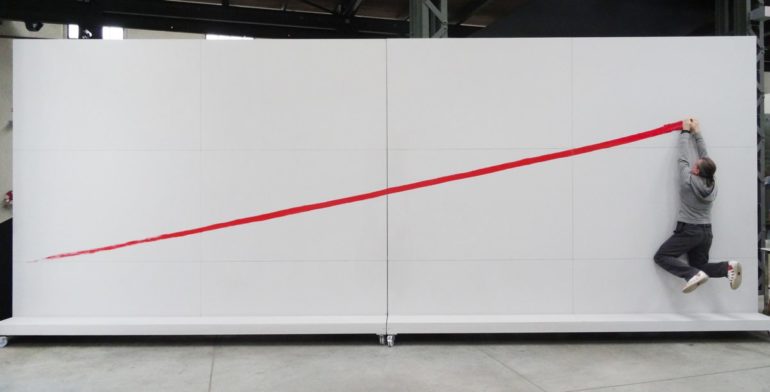Action painting – Thriller painting.
From the test with Spiderman’s web in a glass, it was not far to the showcase, where the action of the color could be even more noticeable. In the first painting of this type from 2009, I allowed Spiderman’s web to move in a defined space in front of the painting. A year later, I also lent Pollock’s color to the web and also tried to imitate his way of rhythmizing the painting surface. However, unlike Pollock, in my experiment the painting itself changes depending on the movement of the viewer. 5

Climbing hold made of red.

Thriller Painting, 2010, 450 × 560 cm, polyester, metal, climbing ropes.

Thriller Painting, 2010, 450 × 560 cm, polyester, metal, climbing ropes.
After a few more experiments of this type, a significant break came in my mural “Thriller Painting”, in which the softness and fragility of colors became an illusion because it was cast in a way of sculpture into a hard, homogeneous mass in order to be able to carry a large load after being mounted on the wall. In this way, the painting became a climbing wall stimulating to action.

Minimax 2, 2010, 204 × 147 × 47 cm, mixed media
Thriller painting, 2010, 450 × 560 cm, polyester, metal, climbing ropes.

Thriller painting, 2010, 450 × 560 cm, polyester, metal, climbing ropes.
1/ I mean the form of action painting represented, for example, by the Japanese Gutai group, Ives Klein and today by Anastasia Ax and many other action artists; I believe that it has been covered in sufficient detail and is quite common.
2/ This is the case of Leon Ferrari’s earthworms, which he threw in the style of Pollock’s drip painting on a horizontally placed canvas. Subsequently the earthworms turned and twisted, personalizing the desired event, and represented a painting material, but not a real painting.
3/ Here I would like to mention the experiments of Gustav Metzger with liquid crystals sensitive to temperature.
4/ The author of Spider-Man is Stan Lee; his character appeared in the comic book anthology “Amazing Fantasy”.
5/ For this purpose I used some op-art concretistic illusions and games (such as Kratina’s mobile reliefs). The resulting spatial painting could evoke a kinetic illusion caused by the movement of a viewer.

Jet painting, 2011, length 8 m, at the beginning of the stroke there is a layer of painting material, which also serves as a climbing hold.

Climbing hold made of black.


Visualization of a climbing wall from action brush strokes.
The layers of paint serve as climbing holds. They are stress-resistant.
